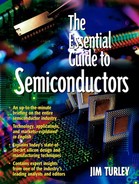Developing Technology: Chips and Photography
If you're an amateur photographer, you'll already understand most of what's involved in making silicon chips. The technique is amazingly similar to the process of developing prints from film negatives. In both cases you start with a sharp negative image on film, which is then projected onto light-sensitive paper resting in a bath of special chemicals. You control exposure, light, and the chemicals to produce just the image and effects you want. You can also enlarge or reduce the image, if desired. Once you've made the first print, it's relatively easy to produce several more just like it.
If you substitute silicon for paper, you've got a pretty accurate description of how chips are made, too. It's basically a photographic process, albeit an extremely accurate and precise one. It's so precise, in fact, that all the equipment must be kept 100 times cleaner than a surgeon's instruments and all the people involved in the process wear astronaut-like sealed spacesuits to prevent contamination. Whereas a photographer's darkroom must be kept dark, a chip factory is brightly lit. The “light” used to develop chips is invisible to the human eye.
Unlike a conventional photograph, though, each “print” of a chip is developed from several different film negatives. A typical chip might require 10 or 20 different layers of film. This is where chip making starts to resemble building a layer cake. Every chip is built of layer on layer of silicon, aluminum, and other chemicals stacked on top of each other like a layer cake or a three-dimensional puzzle. Each layer of this tasty product is developed using a separate piece of film.
